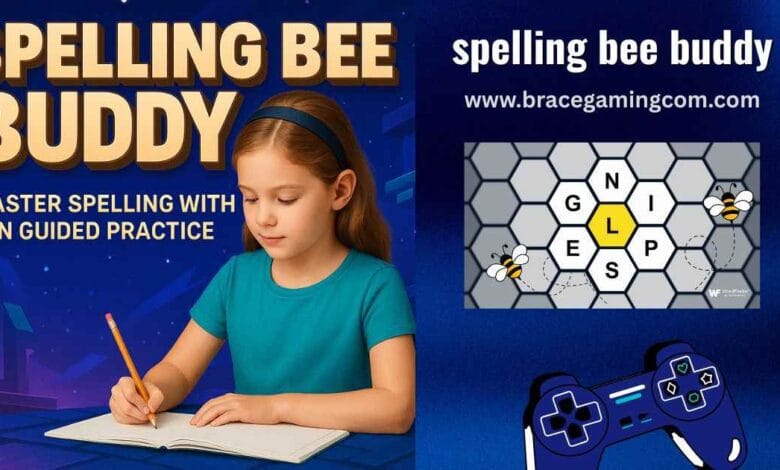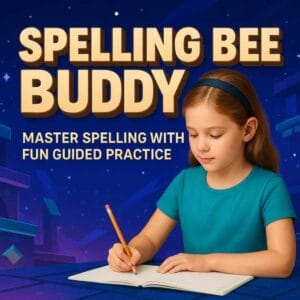Spelling Bee Buddy: Master Spelling with Fun Guided Practice

Spelling Bee Buddy is a practical and student friendly approach to building strong spelling skills through guided practice that is fun and effective. Whether you are a student preparing for a classroom, a parent helping at home or a teacher planning lessons, the strategies and structure in this article will help you create a reliable path to improvement.
The focus keyword spelling bee buddy appears naturally throughout this article so both readers and search engines clearly understand the topic and purpose.
Why consistent spelling practice matters
Consistent practice creates fluency and reduces stress on competition day. Spelling is more than memorizing letters. It links vocabulary pronunciation, etymology, memory strategies and confident public performance. Short regular practice sessions strengthen the retrieval pathways in the brain making it easier to recall words under pressure.
Students who practice consistently also gain better reading comprehension and clearer written expression. For these reasons a steady practice routine is more effective than occasional long study sessions.
What is Spelling Bee Buddy and who is it for

Spelling Bee Buddy describes a study system or tool that combines grade based study lists multiple practice modes audio pronunciation etymology notes progress tracking and mock bee simulation into one easy to use program.
It is designed for elementary and middle school students, competitive spellers, homeschool families and classroom teachers. This approach also works for adults who want to improve vocabulary for school or work. Spelling Bee Buddy adapts to each learner so practice stays focused on individual needs.
How Spelling Bee Buddy works step by step
- Set up a learner profile and choose the appropriate grade or competition level.
- Run a baseline assessment to find strengths and weaknesses.
- Choose daily practice goals in minutes and set weekly targets.
- Use varied practice modes such as listening practice, flash card recall typed practice and mock bee rounds.
- Review missed words using adaptive review that brings problem words back more often.
- Study short etymology notes and pronunciation hints to form memory hooks.
- Run full simulation bees to practice rhythm voice control and time management.
- Check progress reports and adjust study focus based on metrics.
This step by step flow mirrors proven coaching techniques and helps learners move from casual practice to competition readiness in a structured way.
Core features every effective spelling tool needs
A useful spelling companion should include the following core capabilities so learners and teachers get measurable results.
Study lists and level tagging
Organize words by grade or competition level so teachers and students can align practice with classroom or official lists. Easy list selection prevents wasted time on words that are not appropriate for the learner stage.
Multiple practice modes
Include listening practice where the learner hears the word and spells it, typed practice to enforce letter order, flash card recall for quick retrieval, and fill in the blank exercises to improve context recognition. Variety keeps practice engaging and supports different learning styles.
Audio pronunciation and language of origin
Clear audio pronunciation helps students map sound to letters. Short notes on language of origin and common confusions give logical clues and reduce pure rote memorization. These cues are especially useful for unfamiliar words.
Adaptive review and performance tracking
Track which words a learner misses and automatically schedule those words for review more often. Reports that show accuracy trends and common error families let teachers and parents make data driven adjustments to study time.
Mock bee simulation and timed practice
Simulated bees recreate the pressure of a live event and teach students to perform with composure. Timed drills and judge style prompts train rhythm and timing that matter in real bees.
Teacher and classroom support
Teacher accounts that assign lists monitor class progress and provide printable resources make it easy to run a coordinated classroom program. Classroom features improve accountability and scale practice for multiple students.
How Spelling Bee Buddy differs from general spelling apps
General spelling apps often focus on early literacy and phonics while a competition focused approach goes deeper into advanced vocabulary graded study lists etymology and mock bee simulation. A spelling bee oriented program emphasizes competition style words and practice formats that match school and regional bees. For parents and teachers who want competition readiness this added depth makes all the difference.
Building an eight week study plan using Spelling Bee Buddy
This sample eight week plan assumes daily practice of 30 to 60 minutes. Adjust the length and intensity for younger learners or for those preparing for higher level competitions.
Week one Setup and baseline
Create profiles, choose grade based lists and run a baseline quiz to identify weak areas. Familiarize the learner with the study modes and how progress reporting works.
Week two Pronunciation and origin focus
Spend practice time listening to words and studying short language of origin notes. Flag words that cause confusion and add them to a targeted review list.
Week three Spaced review and vocabulary building
Introduce daily short review blocks that retest flagged words and add a small number of new words every two days. Space new words so repetition is effective.
Week four Mock bees and error analysis
Run two mock bees during this week. After each mock bee analyzes errors and group them into common types such as vowel confusion or silent letters.
Week five Root and affix study
Teach common roots prefixes and suffixes and how they change word meaning and spelling. Group words by root to create patterns that accelerate learning.
Week six Timed drills and performance skills
Practice giving and hearing words aloud. Include timed rounds and teach breathing and pacing strategies for the speaker role during a bee.
Week seven Rapid review and targeted correction
Concentrate on the highest frequency missed words. Run short daily bees focused only on these words to build mastery.
Week eight Final simulation and confidence building
Stage a full length simulation in a room that resembles competition conditions. Have one person act as judge and record performance metrics such as accuracy rate and average response time.
After this eight week cycle, repeat the process while increasing difficulty and adding new word lists to maintain steady progress.
Practical session templates you can use today
Use these ready to run session templates to make practice simple and effective.
Short session forty five minutes
- Warm up for five minutes with easy flash cards.
- Core practice twenty minutes on new words and targeted review.
- Etymology study ten minutes on root and origin.
- Mock bee eight minutes with immediate review.
- One minute reflection log to write a learning note.
Quick session twenty minutes
- Warm up for three minutes.
- Targeted review ten minutes focusing on misspelled words.
- Two minute rapid fire flash cards.
- Five minute reflection and spelling trick review.
Intensive session sixty minutes
- Warm up for five minutes.
- New word study twenty minutes including pronunciation and origin.
- Timed drills are ten minutes.
- Mock bee for fifteen minutes with a peer judge.
- Reflection and plan for five minutes.
These templates keep practice focused and ensure each minute is used for deliberate learning.
Memory building techniques and study strategies
- Use language of origin to limit possible letter patterns and spell logically rather than memorizing blindly.
- Break words into syllables and spell each syllable aloud during practice.
- Create a mistake notebook that records the word why it was missed and one short memory trick.
- Use visualization to picture the word in a sentence and anchor a particular letter sequence to a vivid image.
- Teach common confusable letter pairs and patterns so students watch for predictable traps.
These techniques help learners form durable memory traces so recall during a bee becomes automatic.
Common errors and how to correct them

Passive learning
Reading lists without active recall leaves students unprepared. Replace passive reading with active tasks such as writing words from memory and taking short oral quizzes.
Poor pronunciation awareness
When learners do not hear words clearly they confuse vowels and consonant clusters. Regular audio practice and listening drills fix this.
Overloading with new words
Adding too many new words at once leads to shallow learning. Introduce words gradually and keep reviewing frequently.
Ignoring error patterns
Failing to analyze why mistakes occur slows progress. Group errors by pattern and create mini exercises focused on that pattern.
Addressing these issues with adaptive review and focused practice converts errors into learning opportunities.
Measuring progress and useful metrics
Track these core metrics to measure improvement.
- Accuracy rate on weekly quizzes.
- Number of previously missed words that are now correct.
- Average time to spell words during oral drills.
- Results from mock bees and placement in class events.
- Confidence rating using a simple weekly self assessment.
Regular review of these metrics lets you adjust practice emphasis so time is spent where it yields the most improvement.
Teacher friendly classroom implementation ideas
- Set a weekly class goal and run a short in class bee to create friendly competition.
- Use grouped lists for differentiated instruction so learners at different levels practice effectively.
- Provide a single page weekly checklist for students to take home that outlines daily practice steps.
- Schedule monthly mini bees to keep momentum and provide performance feedback.
- Offer a parent training session or handout explaining how to run quick practice sessions at home.
These practical steps help teachers integrate spelling practice into everyday classroom routines without overwhelming students or staff.
Sample lesson plan for a forty five minute class period
- Five minute warm up with whole class flash cards.
- Fifteen minute guided practice on a new list with pronunciation and origin notes.
- Ten minute small group practice where students quiz each other.
- Ten minute mock bee rounds rotating students into the speaker role.
- Five minute wrap up reflection that includes one take away for homework.
This plan balances instruction practice and assessment while encouraging students to lead parts of the session.
Case study example that illustrates the approach
An elementary school champion began with a baseline accuracy of sixty five percent on a grade level list. Over eight weeks of structured practice using targeted review mock bees and root study the student improved to ninety two percent accuracy and became school champion. The biggest gains came from focused review of missed words and regular mock bees that built performance skills.
Positioning Spelling Bee Buddy among other tools
There are many tools for early literacy and general spelling practice. A spelling bee focused approach stands out by offering advanced study lists, etymology notes, adaptive review and mock bee simulation. When choosing or designing a program emphasize clear analytics, teacher friendly features and simple etymology explanations that students can use during recall.
Final words and next steps
Spelling Bee Buddy is a practical and effective framework for mastering spelling through short regular practice adaptive review and realistic mock bees. Start by running a baseline quiz, set daily goals and follow a weekly plan that includes pronunciation origin study and regular mock bees.
Teachers should align lists to classroom needs and use simple reports to guide instruction. With focused effort students steadily improve accuracy, speed and confidence and will be ready to perform their best in school and regional bees.
Frequently asked questions
What is Spelling Bee Buddy and who should use it
Spelling Bee Buddy is a structured method or tool for focused spelling practice. It suits students’ parents and teachers who want a clear path to competition readiness.
How much practice time is ideal each day
Daily short sessions of twenty to sixty minutes depending on goals are more effective than infrequent marathon sessions.
Does the program use official grade lists
A robust program aligns with grade based lists and allows teachers to assign lists that match classroom needs.
Can teachers manage multiple students
Yes teacher dashboards let teachers assign lists track progress and produce printable materials for home practice.
What devices are supported
Modern practice systems are typically available on web and mobile platforms so learners can practice at home or in class.
Is a free tier useful
Free plans are useful for trials but paid tiers often include deeper analytics audio and larger study lists needed for high competition levels.
How does the program protect student data
Choose systems that are transparent about data collection and provide parental controls and school administration options for student accounts.
How does personalization work
Personalization comes from tracking missed words and adjusting review frequency so students spend time on the words they do not yet know.




